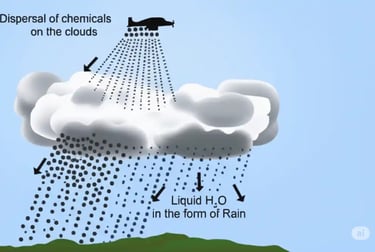Cloud Seeding: A Technological Solution for Delhi’s Air Pollution Crisis
The Delhi government has approved the use of cloud seeding—a technique designed to artificially induce rainfall.
TECHNOLOGY
Thinkbrief
7/14/20255 min read


Delhi has long struggled with some of the worst air pollution levels in the world. Every year, the capital faces dangerously high levels of particulate matter that have serious consequences on the health of its residents. In response, the Delhi government has approved the use of cloud seeding—a technique designed to artificially induce rainfall. This method is being explored as a way to alleviate the toxic air and help reduce pollution levels. Though cloud seeding has been used globally, it is now being tested in Delhi as a potential solution to a growing problem.
What is Cloud Seeding?
Cloud seeding is a method of weather modification aimed at enhancing precipitation. It involves releasing substances like silver iodide or sodium chloride into clouds to encourage the formation of rain. These substances act as nuclei that help water vapor in the cloud condense into larger droplets. These droplets then fall to the ground as rain. In areas where natural conditions do not lead to sufficient rainfall, cloud seeding can help increase the amount of precipitation. It’s especially useful in regions experiencing droughts or water shortages.
The process can be carried out using aircraft or ground-based systems. Aircraft equipped with special dispersing devices fly into clouds and release seeding agents, while ground-based generators can release similar substances into the atmosphere. For cloud seeding to be effective, the weather must be suitable, meaning that there must be moisture in the air and clouds present. While it might sound like science fiction, it’s a well-established practice in some parts of the world and has been shown to increase rainfall in many cases.
How Does Cloud Seeding Work?
Cloud seeding begins with identifying clouds that have enough moisture to produce precipitation but need a little help to do so. Once the right clouds are found, silver iodide or other substances are released into them. These agents serve as a trigger, helping water vapor to condense into larger water droplets. These droplets, once big enough, fall to the ground as rain. The rain that falls helps cleanse the atmosphere by removing pollutants such as dust, smoke, and harmful particles from the air. In places like Delhi, where air pollution is a constant issue, cloud seeding offers a potential short-term solution by improving air quality through rain.
This technique, however, is not a magic bullet. It only works under specific conditions, and the results can vary depending on the amount of moisture available in the clouds. Even when conditions are favorable, the amount of rainfall created by cloud seeding may not be enough to make a significant, lasting impact. It is for this reason that cloud seeding is generally seen as a supplementary tool, rather than a comprehensive solution to environmental challenges.
Cost and Economic Considerations
The cost of cloud seeding varies depending on the scale of the operation. For Delhi, the government has allocated a budget of about ₹7.5 crore for five cloud seeding trials. Each of these trials costs approximately ₹1.5 crore. While this may seem like a substantial investment, the cost of cloud seeding is considered manageable when compared to the potential benefits of reducing pollution, even temporarily. The trials are intended to test the viability of the method and assess whether it can be used more widely to reduce pollution in the city.
However, there are concerns about the long-term cost-effectiveness of cloud seeding. It is an expensive process that requires specialized equipment, trained personnel, and favorable weather conditions. Moreover, while the immediate goal of clearing the air may be achieved, it is unclear whether cloud seeding can provide lasting improvements to air quality. As it stands, the technique may offer only short-term relief from pollution and may need to be repeated frequently to maintain its effects.
Despite these challenges, cloud seeding provides a potential avenue for alleviating Delhi’s pollution crisis, at least temporarily. It offers a different approach when traditional methods like reducing vehicular emissions or regulating industrial pollutants have had limited success in improving air quality.
Why is Cloud Seeding Being Used in Delhi?
Delhi’s air pollution problem has reached alarming levels. The city regularly experiences dangerously high levels of particulate matter (PM2.5 and PM10), which are harmful to health. These pollutants are mainly caused by vehicular emissions, industrial waste, and construction dust. During the winter months, the pollution becomes even more severe, causing respiratory problems and aggravating existing health conditions in millions of people.
Traditional methods to combat pollution, such as improving fuel quality, upgrading transportation systems, and reducing industrial emissions, have not been able to provide a quick fix for the city’s deteriorating air quality. Cloud seeding has been proposed as a novel, short-term solution that can potentially help by inducing rainfall to wash away the harmful pollutants in the air. The aim is to provide some relief from the hazardous air and improve visibility by encouraging rainfall when natural precipitation is insufficient.
The use of cloud seeding is part of a broader strategy by the Delhi government to explore advanced technological interventions in managing the city’s environmental challenges. As Delhi continues to face an ongoing pollution crisis, the government is looking for innovative methods to complement existing efforts. Cloud seeding is being viewed as a possible quick-fix tool to improve air quality, at least for a limited period, giving the authorities some breathing room to implement longer-term measures.
Challenges and Environmental Impact
While cloud seeding has the potential to offer short-term improvements in air quality, it faces several challenges. The effectiveness of the process depends on the presence of suitable clouds, which limits its applicability. Cloud seeding cannot be conducted unless clouds with enough moisture are available. Even when favorable conditions exist, the amount of rain produced by seeding may not be enough to make a noticeable or lasting impact on air pollution levels in a city as polluted as Delhi.
Another concern is the environmental impact of cloud seeding. The substances used in the process, such as silver iodide, are generally considered safe when used in small amounts. However, questions remain about the long-term effects of releasing these chemicals into the atmosphere repeatedly. While there is no strong evidence linking cloud seeding to significant environmental harm, further research is needed to understand the potential risks, especially when carried out on a large scale.
There are also concerns about the cost of continually using cloud seeding as a means to reduce air pollution. It is not a sustainable solution in the long run, especially given the high costs and the temporary nature of its effects. Cloud seeding can be effective in specific situations, but it cannot address the root causes of Delhi’s pollution problem, such as emissions from vehicles and industries.
Looking Ahead
Cloud seeding presents an interesting and innovative solution to Delhi’s air pollution problem. While it may not be the ultimate answer, it provides a new approach to improving air quality, especially in the short term. However, its effectiveness in an urban environment like Delhi remains uncertain, and its long-term impact is still unclear. As the city continues to grapple with air pollution, cloud seeding will likely be used alongside other measures to reduce the harmful effects of pollution on its residents. While it may not be a perfect solution, it represents one step in a broader effort to tackle an increasingly urgent issue.

